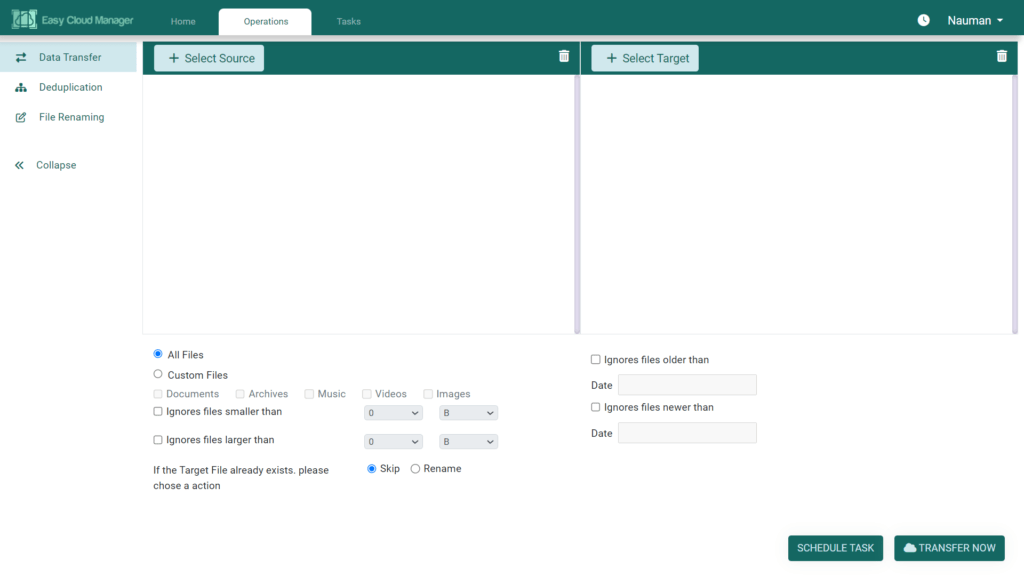If you’re planning to migrate data from GDrive to OneDrive, it may look like a simple and straightforward task. However, downloading data from one cloud platform and re-uploading it to another may turn out to be a challenging task. The Internet speed at your home and the data limits can cause a lot of hurdles during the data transfer. For example, due to the large size of the data, the actual transfer process could take several hours or even a few days.
Product Spotlight: EASY CLOUD MANAGER (ECM) to transfer files across clouds. ECM uses official cloud APIs and provides amazing options to manage files on cloud. Use it free here: https://www.easycloudmanager.com/

Sudden Internet disconnections and drop-outs might force you to search for incompletely downloaded files and restart the downloads from scratch. In the end, you may waste a lot of precious time, Internet bandwidth and some files could be broken or not downloaded correctly. This is why it is always advisable to use a cloud migration solution rather than manually download and transfer your data. Worry not, in this article we’ll get you covered about some easy methods to transfer your data.
Why Migrate from GDrive to OneDrive?
Here are some possible scenarios why you might want to migrate your data from Google Drive service to Microsoft OneDrive:
- Maybe you’re running short of your Google Drive storage and need to migrate some large files to OneDrive so that you can free up some storage and make room for new files
- Maybe you’re collaborating with your colleagues through OneDrive and need to access some large files stored on your GDrive account
- Maybe you’ve got a complimentary subscription of 1 TB OneDrive storage as part of your Microsoft Office 365 subscription and wish to migrate your existing data to OneDrive to avail the benefits
Method 1: Request Google to Generate an Archive of Your Data
Google makes it entirely easy to download your personal files in the form of an archive. Using the Google Takeout page, you can request a single large archive of your data or multiple archives that are smaller in size.
The Google Takeout page lets you download your private data from Google servers regardless of whichever Google service you use. It facilitates a centralized place to download your Google Drive files, email and calendar events, contacts, Google Photos, and more.
- Go to your Google Account page.
- Click on the Data & Personalization tab on the right-hand side panel.
- Click the Download your Data button under Download, delete or make a plan for your data section.
- By default, Google auto-selects all the Google products/ services to include them in your final archive file.
- For the purpose of this article, click on the Deselect all link, and then check the box in front of the Google Drive service to include it in your Google Archive file. (Similarly, you can check other services to include them in your archive file).
- Click the Next step button.
- Click on Send download link via email to receive the archive download link sent to your email. The archiving may take some time depending on the size of your data.
- Select your desired compressed file format. For example, .zip, .rar, .tgz.
- Set an archive size limit (for example, 4 GB). If you’ve got a large chunk of data, the Google Archive file may be large in size. You may want to split the archive into smaller files to easily download your files.
- Follow the on-screen instructions to download your archive.
After downloading your archive, you may want to extract its contents using a file compression program such as WinZip, WinRar or free 7-Zip. Now, upload your files to OneDrive.
Method 2: Using MultCloud
MultCloud is not free. However, it offers a limited free plan that caps your monthly bandwidth limit and provides cloud migration functionality. You can migrate Google Drive files to not only OneDrive, but also OneDrive for Business, SugarSync, Dropbox, FTP/ SFTP, MediaFire, Yandex, MyDrive, HiDrive, MySQL, and tons of other services. Cloud migration becomes as simple as just copy-paste.
Features:
- Provides a simple way to transfer files without downloading them to your computer.
- A fully browser-based file migration tool. You don’t need to download any software.
- Supports an extensive list of cloud services to enable multi-cloud migration without much effort.
Create MultCloud Account:
- Go to the MultCloud website.
- Click on Sign Up.
- Enter your email, user name, password and verification code.
- Click on Create Account.
- You’ll receive a new email from MultCloud containing your validation link. Click on that link to activate your account instantly.
Add Source Drive (Google Drive):
- Click on the Add Cloud Drives icon on the left sidebar.
- Select Google Drive as the source drive.
- Click on Next.
- On the next page, you’ll be prompted to enter your login credentials. Type your email address and password, and click on Allow when you’re prompted to allow file sharing access to the MultCloud service.
- Type a display name for your drive and then finish adding.
Add Destination Drive (OneDrive):
The process is quite similar. Here, you’ll need to click the OneDrive icon, click on Next and sign in using your OneDrive account. Again, you’ll be prompted to enter your OneDrive login credentials and approve file-sharing permissions. After approving them, enter a display name and you’re done.
Start Transfer:
- Click on Cloud Transfer.
- Specify Google Drive as your Source Drive, and OneDrive as your Destination.
- Click on Transfer Now.
- The transfer will start automatically.
Warning: Undefined array key "author_box_bio_source" in /home1/clonefil/public_html/blog/wp-content/plugins/molongui-authorship/views/author-box/parts/html-bio.php on line 2
Raza Ali Kazmi works as an editor and technology content writer at Sorcim Technologies (Pvt) Ltd. He loves to pen down articles on a wide array of technology related topics and has also been diligently testing software solutions on Windows & Mac platforms. If you have any question about the content, you can message me or the company's support team.

